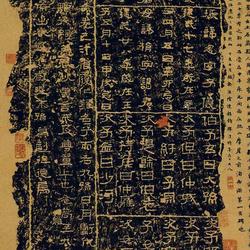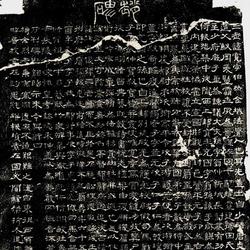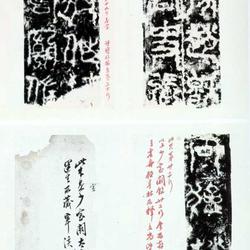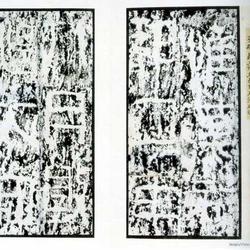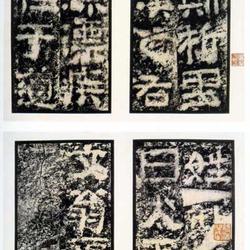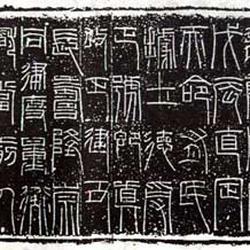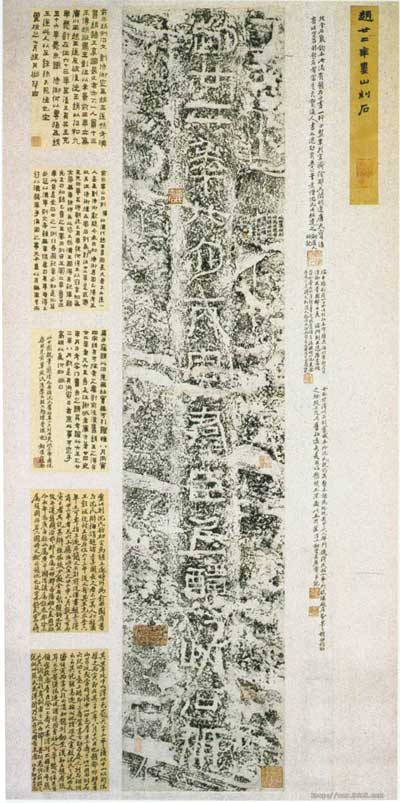
Engraved in the sixth year of Emperor Wen of the Han Dynasty (158 BC). The original stone was found by Yang Zhaohuang during his visit to Loushan, 60 miles west of Yongnian County, Guangping Prefecture, Zhili (now Yongnian County, Hebei Province) during the Daoguang period of the Qing Dynasty, so it is also called "Zhao Loushan Carving Stone". The seal script of the Han Dynasty has changed from the rectangular shape of the small seal script of the Qin Dynasty to a square one. Its calligraphy is crude and natural, with full strokes. Lu Zengxiang of the Qing Dynasty believed that "Judging from the style of writing, it seems to be different from the Qin seal script. The two characters Bingyin are folded when the pen is turned, which is all official."
Experts generally believe that this stone was carved by ministers of the State of Zhao in the Western Han Dynasty when they celebrated the birthday of their king Liu Sui. The 22nd year of Zhao was the sixth year of Houyuan (158 BC) after Emperor Liu Heng of Han Dynasty. There are very few carved stones handed down from the Western Han Dynasty, and this stone is the earliest. Moreover, its font is simple and clumsy, and the seal script also contains official script. It can be called a representative work of calligraphy during the transitional period between seal script and official script between the Qin and Han Dynasties. Some experts also believe that the "Zhao" name of this stone is from the "Later Zhao" in the 4th century AD, or from the "Zhao State" in the Warring States Period.
This rubbing contains a postscript in small regular script by Zhao Zhiqian. The right side is framed with an inscription by Chen Shuyong and three postscripts by Wu Guangpei. On the left side are two letters (three pages) written by Yu Yue on his research on this stone age, and a postscript by Wu Guangpei (two pages). Appraisal seals include: "Shen's epigraphy", "Junchu treasure", "Jichuan Hu Shu, Chuansha Shen Shuyong, Renhe Wei Xizeng, Kuaiji Zhao Zhiqian simultaneously approved the seal", "Wulin Han Xiaoting's appraisal of epigraphy", "Xuyi Wu Tongyuan" "Gongwang's father approved the seals of calligraphy and painting on gold and stone", "Danghu Zhushan Banner built Qing's father's collection", etc.
The main records about this stone include: Zhao Zhiqian of the Qing Dynasty's "Records of the Monuments Visited by Huanyu", Shen Xiyong's "Notes of Jiao Cuixuan", Zhang Derong's "Gathering of Gold and Stones in the Erming Cottage", Lu Zengxiang's "Correction of the Gold and Stones of the Baqiong Room", and Yang Shoujing's "Hormone Feiqing Pavilion" Commentary on Steles", modern Zhang Yansheng's "Rare Books on Steles", Sha Menghai's "Illustrated Records of the History of Chinese Calligraphy", etc.
Explanation: In August of the 22nd year of Zhao Dynasty, all the ministers of Bingyin lived in this stone north.

